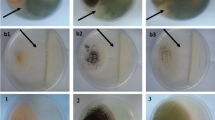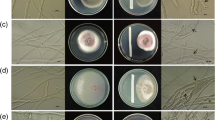Abstract
Non-pathogenic yeasts antagonising microorganisms that cause pre- and postharvest diseases of plants have been found in diverse habitats. Their practical applicability as biocontrol agents (BCAs) depends on the strength of their antagonistic activity and/or spectrum of sensitive target microorganisms. In this study, yeasts were isolated from the phylloplane and fruits of plants growing in the alkaline water lake region Wadi El-Natrun, Egypt, and tested for antifungal and antibacterial activity. All phylloplane yeast isolates belonged to the Basidiomycota and most of them could antagonise at least certain test organisms. One group of isolates showing strong antagonism against almost all fungi and yeasts appears to represent a hitherto undescribed species distantly related to the smut genus Sporisorium. This is the first report of antagonistic activity in Sporisorium. The isolates assigned to Naganishia and Papiliotrema were more effective against bacteria. The broadest range and intensity of antagonism was observed in the fruit-associated strains belonging to the ascomycetous species Wickerhamomyces subpelliculosus. The Wickerhamomyces strains are good broad-spectrum BCA candidates, the Sporisorium strains could be used as efficient antifungal BCAs, whereas the Papiliotrema isolate can be exploited as an antibacterial biocontrol agent.



Similar content being viewed by others
References
Abd El-Ghani MM, Huerta-Martínez FM, Hongyan L, Qureshi R (2017) Plant responses to hyperarid desert environments. Springer, Cham
Avis TJ, Bélanger RR (2002) Mechanisms and means of detection of biocontrol activity of Pseudozyma yeasts against plant-pathogenic fungi. FEMS Yeast Res 2:5–8
Boekhout T (2011) Pseudozyma Bandoni emend. Boekhout (1985) and a comparison with the yeast state of Ustilago maydis (De Candolle) Corda (1842). In: Kurtzman CP, Fell JW, Boekhout T (eds) The yeasts, a taxonomic study. Elsevier, Amsterdam, pp 1857–1868
Buxdorf K, Rahat I, Gafni A, Levy M (2013) The epiphytic fungus Pseudozyma aphidis induces jasmonic acid- and salicylic acid/nonexpressor of PR1-independent local and systemic resistance. Plant Physiol 161:2014–2022
Calvo J, Calvente VDE, Orellano M, Benazzi D, Tosetti M (2003) Improvement in the biocontrol of postharvest diseases of apple with the use of yeast mixture. Biocontrol 48:579–593
Chan Z, Tian S (2005) Interaction of antagonistic yeasts against postharvest pathogens of apple fruit and possible mode of action. Postharvest Biol Technol 36:215–223
Chen L, Heng J, Qin S, Bian K (2018) A comprehensive understanding of the biocontrol potential of Bacillus velezensis LM2303 against Fusarium head blight. PLoS ONE 13:e0198560
Ciancio A, Pieterse CM, Mercado-Blanco J (2016) Editorial: harnessing useful rhizosphere microorganisms for pathogen and pest biocontrol. Front Microbiol 19:1620
Cortes-Tolalpa L, Norder J, van Elsas JD, Falcao Salles J (2018) Halotolerant microbial consortia able to degrade highly recalcitrant plant biomass substrate. Appl Microbiol Biotechnol 102:2913–2927
de Almeida Lopes KB, Carpentieri-Pipolo V, Oro TH, Stefani Pagliosa E, Degrassi G (2016) Culturable endophytic bacterial communities associated with field-grown soybean. J Appl Microbiol 120:740–755
Dukare AS, Sangeeta P, Nambi VE, Gupta R, Sharma K, Vishwakarma RK (2018) Exploitation of microbial antagonists for the control of postharvest diseases of fruits: a review. Crit Rev Food Sci Nutr 16:1–16
El-Banna AA, Malak AE, Shehata MG (2011) Yeasts producing killer toxins: an overview. Alex J Food Sci Technol 8:41–53
Fan Q, Tian SP (2001) Postharvest biological control of grey mold and blue mold on apple by Cryptococcus albidus (Saito) Skinner. Postharvest Biol Technol 21:341–350
Golubev WI (2006) Antagonistic interactions among yeast. In: Rosa C, Peter G (eds) Biodiversity and ecophysiology of yeasts. Springer, Berlin, pp 197–219
Gross S, Kunz L, Müller DC, Santos Kron A, Freimoser FM (2018) Characterization of antagonistic yeasts for biocontrol applications on apples or in soil by quantitative analyses of synthetic yeast communities. Yeast. https://doi.org/10.1002/yea.3321
Guindon S, Dufayard JF, Lefort V, Anisimova M, Hordijk W, Gascuel O (2010) New algorithms and methods to estimate maximum-likelihood phylogenies: assessing the performance of PhyML 3.0. System Biol 59:307–321
Hajlaou MR, Traquair JA, Jarvis WR, Belanger RR (1994) Antifungal activity of extracellular metabolites produced by Sporothrix flocculosa. Biocontrol Sci Technol 4:229–237
Jarvis WR, Shaw LA, Traquair JA (1989) Factors affecting antagonism of cucumber powdery mildew by Stephanoascus flocculosus and S. rugulosus. Mycol Res 92:162–165
Kemler M, Witfeld F, Begerow D, Yurkov A (2017) Phylloplane yeasts in temperate climates. In: Buzzini P, Lachance M-A, Yurkov A (eds) Yeasts in natural ecosystems: diversity. Springer, Cham, pp 171–198
Lane DJ (1991) 16S/23S rRNA sequencing. In: Goodfellow M, Stackebrandt E (eds) Nucleic acid techniques in bacterial systematics. Wiley, New York, pp 115–175
Le Mire G, Nguyen ML, Fassotte B, du Jardin P, Verheggen F, Delaplace P, Jijakli MH (2016) Review: implementing plant biostimulants and biocontrol strategies in the agroecological management of cultivated ecosystems. Biotechnol Agron Soc Environ 20(S):299–313
Lee G, Lee SH, Kim KM, Ryu CM (2017) Foliar application of the leaf-colonising yeast Pseudozyma churashimaensis elicits systemic defense of pepper against bacterial and viral pathogens. Sci Rep 10:39432
Leyva Salas M, Mounier J, Valence F, Coton M, Thierry A, Coton E (2017) Antifungal microbial agents for food biopreservation—a review. Microorganisms 5:37
Limtong S, Nasanit R (2017) Phylloplane yeasts in tropical climates. In: Buzzini P, Lachance M-A, Yurkov A (eds) Yeasts in natural ecosystems: diversity. Springer, Cham, pp 199–224
Liu J, Sui Y, Wisniewski M, Droby S, Liu Y (2013) Review: utilization of antagonistic yeasts to manage postharvest fungal diseases of fruit. Int J Food Microbiol 167:153–160
Liu GL, Chi Z, Wang GY, Wang ZP, Li Y, Chi ZM (2015) Yeast killer toxins, molecular mechanisms of their action and their applications. Crit Rev Biotechnol 35:222–234
Mari M, Di Francesco A, Bertolini P (2014) Control of fruit postharvest diseases: old issues and innovative approaches. Stewart Postharvest Rev 1:1–4
McTaggart AR, Shivas RG, Boekhout T, Oberwinkler F, Vánky K, Pennycook SR et al (2016) Mycosarcoma (Ustilaginaceae), a resurrected generic name for corn smut (Ustilago maydis) and its close relatives with hypertrophied, tubular sori. IMA Fungus 7:309–315
Mimee B, Labbé C, Pelletier R, Bélanger RR (2005) Antifungal activity of flocculosin, a novel glycolipid isolated from Pseudozyma flocculosa. Antimicrob Agents Chemother 49:1597–1599
Mimee B, Pelletier R, Bélanger RR (2009) In vitro antibacterial activity and antifungal mode of action of flocculosin, a membrane-active cellobiose lipid. J Appl Microbiol 107:989–996
Muccilli S, Restuccia C (2015) Bioprotective role of yeasts. Microorganisms 3:588–611
O’Donell K (1993) Fusarium and its near relatives. In: Reynolds DR, Taylor JW (eds) The fungal holomorph: mitotic, meiotic and pleomorphic speciation in fungal systematics. CAB International, Wallingford, pp 225–233
Parvatha Reddy P (2016) Sustainable crop protection under protected cultivation. Springer, Singapore
Pérez-Montaño F, Alías-Villegas C, Bellogín RA, del Cerro P, Espuny MR, Jiménez-Guerrero I, López-Baena FJ, Ollero FJ, Cubo T (2013) Plant growth promotion in cereal and leguminous agricultural important plants: from microorganism capacities to crop production. Microbiol Res 169:325–336
Pipenberg M (2003) Smut fungi (Ustilaginomycetes p.p. and Microbotryales, Basidiomycota). Flora Neotrop 86:1–291
Sambrook J, Fritsch EF, Maniatis T (1989) Molecular cloning: a laboratory manual. Cold Spring Harbor Laboratory Press, Cold Spring Harbor
Sharma RR, Singh D, Singh R (2009) Biological control of postharvest diseases of fruits and vegetables by microbial antagonists: a review. Biol Control 50:205–221
Sipiczki M (2003) Candida zemplinina sp. nov., an osmotolerant and psychrotolerant yeast that ferments sweet botrytised wines. Int J System Evol Microbiol 53:2079–2083
Sipiczki M (2006) Metschnikowia strains isolated from botrytized grapes antagonise fungal and bacterial growth by iron depletion. Appl Environ Microbiol 72:6716–6724
Sipiczki M (2016) Overwintering of vineyard yeasts: survival of interacting yeast communities in grapes mummified on vines. Front Microbiol 7:212
Sipiczki M, Ferenczy L (1978) Enzymic methods for enrichment of fungal mutants. I. Enrichment of Schizosaccharomyces pombe mutants. Mutat Res 50:153–173
Sipiczki M, Horvath E, Pfliegler PW (2018) Birth-and-death evolution and reticulation of ITS segments of Metschnikowia andauensis and Metschnikowia fructicola rDNA repeats. Front Microbiol 9:1193
Stoll M, Begerow D, Oberwinkler F (2005) Molecular phylogeny of Ustilago, Sporisorium, and related taxa based on combined analyses of rDNA sequences. Mycol Res 109:342–356
Taher AG (1999) Inland saline lakes of Wadi El Natrun depression, Egypt. Int J Salt Lake Res 8:149–169
Thompson JD, Higgins DG, Gibson TJ (1994) CLUSTALW: improving the sensitivity of progressive multiple sequence alignment through sequence weighting, positions-specific gap penalties and weight matrix choice. Nucleic Acids Res 22:4673–4680
Usall J, Torres R, Teixido N (2016) Biological control of postharvest diseases on fruit: a suitable alternative? Cur Opin Food Sci 11:51–55
Vishniac HS (2002) Cryptococcus tephrensis, sp.nov., and Cryptococcus heimaeyensis, sp.nov.; new anamorphic basidiomycetous yeast species from Iceland. Can J Microbiol 48:463–467
Vu D, Groenewald M, Szöke S, Cardinali G, Eberhardt U, Stielow B et al (2016) DNA barcoding analysis of more than 9 000 yeast isolates contributes to quantitative thresholds for yeast species and genera delimitation. Stud Mycol 85:91–105
Wang Q-M, Begerow D, Groenewald M, Liu X-Z, Theelen B, Bai F-Y et al (2015) Multigene phylogeny and taxonomic revision of yeasts and related fungi in the Ustilaginomycotina. Stud Mycol 81:55–83
Weyens N, Beckers B, Schellingen K, Ceulemans R, Croes S, Janssen J et al (2013) Plant-associated bacteria and their role in the success or failure of metal phytoextraction projects: first observations of a field-related experiment. Microbial Biotechnol 6:288–299
White TJ, Bruns TD, Lee S, Taylor JW (1990) Amplification and direct sequencing of fungal ribosomal RNA genes for phylogenetics. In: Innis MA, Gelfand D, Sninsky JS, White TJ (eds) PCR protocols: a guide to methods and applications. Academic Press, San Diego, pp 315–322
Young TW, Yagiu M (1978) A comparison of the killer character in different yeasts and its classification. Antonie Van Leeuwenhoek 44:59–77
Yurkov A, Inácio J, Chernov IY, Fonseca Á (2015) Yeast biogeography and the effects of species recognition approaches: the case study of widespread basidiomycetous species from birch forests in Russia. Cur Microbiol 70:587–601
Zhimo VY, Bhutia DD, Saha J, Panja B (2014) Exploitation of yeasts as an alternative strategy to control post harvest diseases of fruits. World Appl Sci J 31:785–793
Acknowledgements
Samy A. Selim thanks Tempus Public Foundation, Hungary (Grant No. 20004) for supporting his postdoctoral research in Hungary. We thank prof. Gamal El-Din for the taxonomic identification of plants and Anita Csabai-Olah for excellent technical assistance.
Author information
Authors and Affiliations
Contributions
MS Conceived and designed study. MS, SAS Performed research. MS Analysed data. MS Wrote the paper.
Corresponding author
Ethics declarations
Conflict of interest
No conflict of interest to declare.
Rights and permissions
About this article
Cite this article
Sipiczki, M., Selim, S.A. Antagonistic yeasts from a salt-lake region in Egypt: identification of a taxonomically distinct group of phylloplane strains related to Sporisorium. Antonie van Leeuwenhoek 112, 523–541 (2019). https://doi.org/10.1007/s10482-018-1184-8
Received:
Accepted:
Published:
Issue Date:
DOI: https://doi.org/10.1007/s10482-018-1184-8




